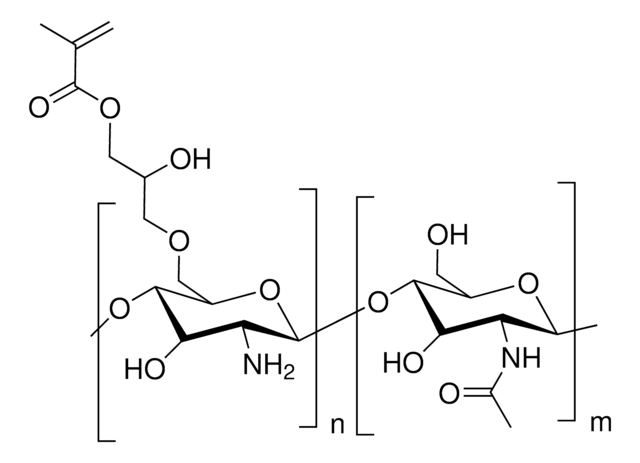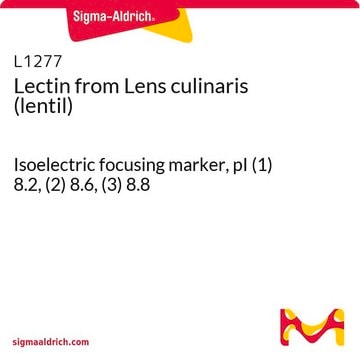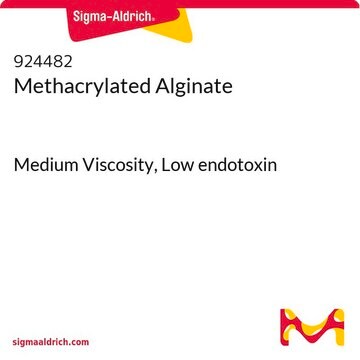934798
Gelatin acrylate
gel strength 300 g Bloom, degree of substitution 60%
Sinonimo/i:
Gelatin acrylate, Acrylated gelatin
Autenticatiper visualizzare i prezzi riservati alla tua organizzazione & contrattuali
About This Item
Formula condensata:
(C40H59N11O13)n
Codice UNSPSC:
12352202
NACRES:
NA.21
Prodotti consigliati
Livello qualitativo
Forma fisica
powder or chunks (fibers)
Colore
white to off-white
Temperatura di conservazione
−20°C
Categorie correlate
Descrizione generale
Gelatin is a natural biopolymer derived from collagen that plays an important role in the biomedical field due to its biocompatibility, biodegradability, and nonimmunogenicity. Acrylate-functionalized gelatin, or gelatin acrylate, can be crosslinked using thiol-Michael click chemistry as well as photochemical crosslinking. It′s properties are very similar to gelatin methacrylate (GelMA). Crosslinked gelatin hydrogels have many applications in tissue engineering and 3D bioprinting.
Applicazioni
- Endothelial cell morphogenesis
- Injectable tissue constructs
- Tissue engineering of multiple tissue types including heart tissue (cardiomyocytes), bone tissue (osteogenesis), cartilage tissue (chondrogenesis), and epidermal tissue
- Drug delivery applications including contact lens and dental
Caratteristiche e vantaggi
- Photopolymerizable
- Clickable
- Biocompatible
- Biodegradable
Prodotti correlati
N° Catalogo
Descrizione
Determinazione del prezzo
Codice della classe di stoccaggio
11 - Combustible Solids
Classe di pericolosità dell'acqua (WGK)
WGK 1
Punto d’infiammabilità (°F)
Not applicable
Punto d’infiammabilità (°C)
Not applicable
Certificati d'analisi (COA)
Cerca il Certificati d'analisi (COA) digitando il numero di lotto/batch corrispondente. I numeri di lotto o di batch sono stampati sull'etichetta dei prodotti dopo la parola ‘Lotto’ o ‘Batch’.
Possiedi già questo prodotto?
I documenti relativi ai prodotti acquistati recentemente sono disponibili nell’Archivio dei documenti.
Hongyuan Zhu et al.
Journal of the mechanical behavior of biomedical materials, 88, 160-169 (2018-09-03)
Biocompatible hydrogels with defined mechanical properties are critical to tissue engineering and regenerative medicine. Thiol-acrylate photopolymerized hydrogels have attracted special interest for their degradability and cytocompatibility, and for their tunable mechanical properties through controlling factors that affect reaction kinetics (e.g.
Xin Zhao et al.
Advanced healthcare materials, 5(1), 108-118 (2015-04-17)
Natural hydrogels are promising scaffolds to engineer epidermis. Currently, natural hydrogels used to support epidermal regeneration are mainly collagen- or gelatin-based, which mimic the natural dermal extracellular matrix but often suffer from insufficient and uncontrollable mechanical and degradation properties. In
Chaenyung Cha et al.
Biomacromolecules, 15(1), 283-290 (2013-12-19)
Microfabrication technology provides a highly versatile platform for engineering hydrogels used in biomedical applications with high-resolution control and injectability. Herein, we present a strategy of microfluidics-assisted fabrication photo-cross-linkable gelatin microgels, coupled with providing protective silica hydrogel layer on the microgel
Kelly M C Tsang et al.
Advanced functional materials, 25(6), 977-986 (2015-09-04)
Hydrogels are often employed as temporary platforms for cell proliferation and tissue organization in vitro. Researchers have incorporated photodegradable moieties into synthetic polymeric hydrogels as a means of achieving spatiotemporal control over material properties. In this study protein-based photodegradable hydrogels
Aleksander Skardal et al.
Tissue engineering. Part A, 16(8), 2675-2685 (2010-04-15)
Bioprinting by the codeposition of cells and biomaterials is constrained by the availability of printable materials. Herein we describe a novel macromonomer, a new two-step photocrosslinking strategy, and the use of a simple rapid prototyping system to print a proof-of-concept
Il team dei nostri ricercatori vanta grande esperienza in tutte le aree della ricerca quali Life Science, scienza dei materiali, sintesi chimica, cromatografia, discipline analitiche, ecc..
Contatta l'Assistenza Tecnica.






